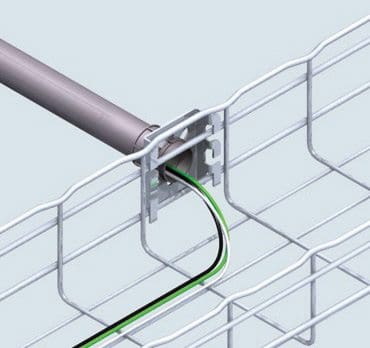Separation distances
In situations where there are a large number of cables varying in voltage and current levels, the IEEE 518-1982 standard has developed a useful set of tables indicating separation distances for the various classes of cables.There are four classification levels of susceptibility for cables.
Susceptibility, in this context, is understood to be an indication of how well the signal circuit can differentiate between the undesirable noise and required signal. It follows that a data communication physical standard such as RS-232E would have a high susceptibility, and a 1000-V, 200-A AC cable has a low susceptibility.
IEEE 518 – 1982 standard
The four susceptibility levels defined by the IEEE 518 – 1982 standard are briefly:Level 1 (High) - This is defined as analog signals less than 50 V and digital signals less than 15 V. This would include digital logic buses and telephone circuits. Data communication cables fall into this category.
Level 2 (Medium) - This category includes analog signals greater than 50 V and switching circuits.
Level 3 (Low) - This includes switching signals greater than 50 V and analog signals greater than 50 V. Currents less than 20 A are also included in this category.
Level 4 (Power) - This includes voltages in the range 0–1000 V and currents in the range 20–800 A. This applies to both AC and DC circuits.
Both cables contained in a separate tray:
- Level 1 to level 2-30 mm
- Level 1 to level 3-160 mm
- Level 1 to level 4-670 mm
- Level 1 to level 2-30 mm
- Level 1 to level 3-110 mm
- Level 1 to level 4-460 mm
- Level 1 to level 2-30 mm
- Level 1 to level 3-80 mm
- Level 1 to level 4-310 mm.
Trays and conduits

Cable tray/conduit (photo credit: Legrand)
A few words need to be said about the construction of the trays and conduits. It is expected that the trays are manufactured from metal and be firmly earthed with complete continuity throughout the length of the tray. The trays should also be fully covered preventing the possibility of any area being without shielding.
Briefly galvanic noise
can easily be avoided by refraining from the use of a shared signal
reference conductor, in other words, keeping the two signal channels
galvanically separate so that no interference takes place.
Physical separation between the noise source and the receptor will also reduce magnetic coupling and therefore the interference.
Twisting of signal conductors
Twisting of signal conductors is another way to reduce EMI. The polarity of induced voltage will be reversed at each twist along the length of the signal cable and will cancel out the noise voltage. These are called twisted pair cables.
Multishield cable (Foil and Braid) – photo credit: multicable.com
Electrostatic interference can be prevented or at least minimized by the use of shields. A shield is usually made of a highly conductive material such as copper, which is placed in the path of coupling. An example is the use of a shield, which is placed around a signal conductor.
When a noise voltage
tries to flow across the capacitance separating two conductors, say a
power and a signal conductor (actually through the insulation of the
conductors), it encounters the conducting screen, which is connected to
ground. The result is that the noise is diverted to ground through
the shield rather than flowing through the higher impedance path to the
other conductor.
If the shield is not of a high conductive material, the flow of the diverted current through the shield can cause a local rise of voltage in the shield, which can cause part of the noise current to flow through the capacitance between the shield and the second conductor.
This is really helpful for businesses looking for reliable wire harness suppliers.
ReplyDeleteBest Wire harness manufacturers in USA